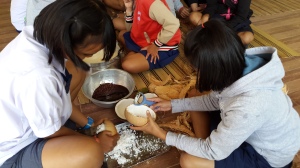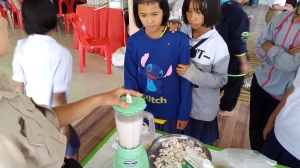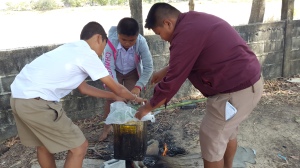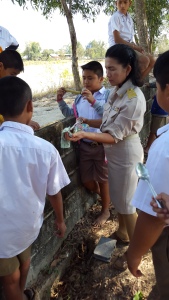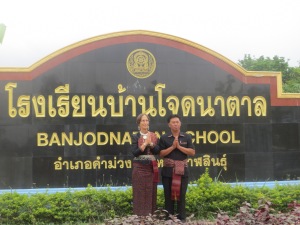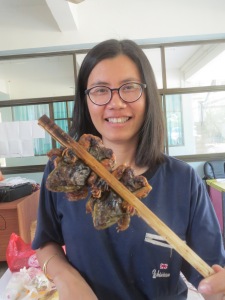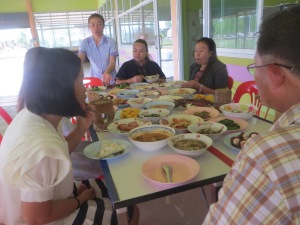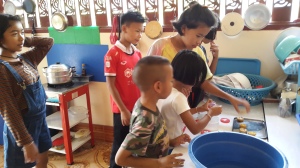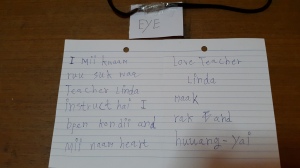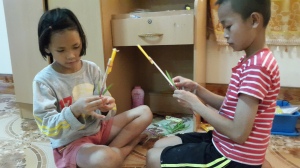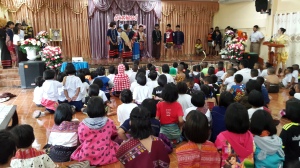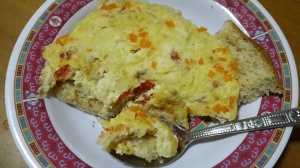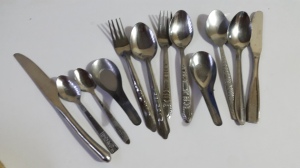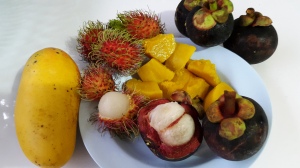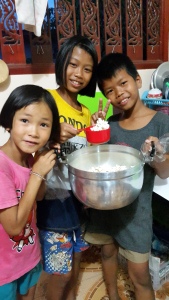With the oscillating fan sitting in the perfect location (close enough to keep us cool and distant enough to not interfere with our Uno cards) we sit on the living room floor, moaning or giggling when someone places a “Draw +2” or a “Wild +4” on the growing discard pile.
The children talk to each other in their local Issan language. Then one of them looks at me.
Chocolate pudding?
She asks hopefully in English. Making chocolate pudding is currently their favorite post-card-game cooking/eating activity.
“Not today. We’ll make chocolate pudding on Saturday.”
The student translates the day (Wan-sao) to make sure everyone understands. Then she looks at me and asks me for their second choice.
Snowman cookies?
“Yes. Today we’ll make snowman cookies.”
We finish the game and make snowman cookies with chocolate chip eyes, a round-candy nose, and a strawberry jam mouth. They say thank you as they take their cookies home.
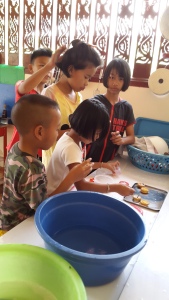
Making snowman cookies.
On Saturday we play Skip-Bo in front of the fan. In the middle of the second game, a student checks to confirm our post-game activity.
Today chocolate pudding?
“Yes. We’ll make chocolate pudding today – after this game.”
No translation needed. Everyone heard “yes.” They smile and nod. And maybe we play the game a bit faster.
Best, the youngest student, wins the game. We stuff the cards back into the well-worn box. It feels like a race to the kitchen where the students automatically wash their hands.
Eye, the oldest student, retrieves the recipe book off the shelf. She thumbs through the hand-written notebook looking for the correct recipe.
She finds a page, points to a recipe name, and looks at me with raise eyebrows.
Chocolate pudding? Her eyes ask me.
I look at the recipe she found. “No. That’s custard pudding.”
She turns some more pages.
She finds another promising option and points.
Chocolate pudding? This time she uses words.
“No. That’s chocolate cake.”
She continues looking for the chocolate pudding recipe.
Her voice is confident on her next choice. Perhaps she remembers the way the recipe was written or maybe she sees a trace of cocoa powder on the page.
Chocolate pudding! She announces.
“Yes. You are right. What do we need?”
Twelve-year-old Eye takes five steps across the kitchen to remove the small saucepan from the hook between the stove and the door. She sets the pan on the table.
Seven-year-old Best grabs the whisk from another hook. He squishes the whisk into his hand and lets it bounce back into shape. The children giggle at his magic.
Eye checks the ingredients and directs the younger children.
Sugar. Blue cup. One student finds the opaque plastic container labeled “Sugar.” Another student gets the blue measuring cup. Eye fills the half-cup measuring cup with grainy tan sugar. She hands the cup to another child who dumps it into the saucepan.
Cocoa. Green cup. Eye has made chocolate pudding several times – often enough to read the ingredients and remember the color-coded cup needed for each item. Her sous chefs find the cocoa container and the correct measuring cup. They add one-third cup cocoa to the saucepan.
Corn starch. As one student grabs the old peanut-butter jar with the blue lid that contains corn starch, Eye finds the white Tablespoon. They measure and dump two tablespoons corn starch to the saucepan.
Salt. Eye finds the smallest measuring spoon and lets another student add a bit of salt to the pan.
With all the dry ingredients in the saucepan, each student takes a turn whisking the powders together.

Stirring the dry ingredients together with a whisk.
Eye gets a cereal bowl and a couple of smaller bowls.
Two eggs. Two milk.
Two different students each crack an egg into a small bowl. They capture and carefully pour the egg yolks into the cereal bowl. Two students each cut open a 100 ml boxes of shelf-stable milk. Under Eye’s guidance, they take turns whisking the egg yolks while gradually adding the milk.
When the dry ingredients are dissolved, Eye carries the saucepan to the stove. They wait without a sound as I turn on the propane. As I move to turn the knob on the stove, they echo my “Stand back.”
We use a big red spoon and take turns stirring. Gradually the sweet-smelling dark brown liquid gets thicker. Students count how many people will eat the pudding; they line up five ceramic ramekins and place a small spoon in each one.
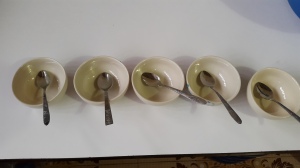
Ramekins lined up – ready for hot chocolate pudding!
In a few minutes, small bubbles form and the pudding starts to boil. We stir constantly as the pudding boils for one minute. I turn off the gas and the stove and we let the pudding cool for a minute. I put a heaping spoonful of pudding in each ramekin. Then I add another smaller spoonful to each serving.
We each carry our tiny ramekins with hot chocolate pudding to the living room. We eat.
The teacher in me can’t resist reviewing the English vocabulary. “Yummy chocolate pudding! What’s in it?” Children take turns naming the ingredients and the amounts. Cocoa: green cup. Sugar: blue cup. Milk: two. Eggs: two.
They experiment with the feel and look of chocolate pudding in their mouths. They pose for pictures.
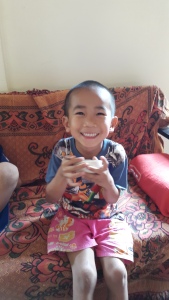
Pure joy!
He didn’t play Skip-Bo or help make the pudding. But he arrived just in time to eat it!
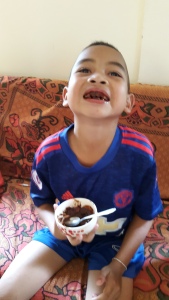
A chocolate-ty grin
We soon take our empty bowls and licked-clean spoons to the kitchen. We wash dishes.
They politely say thank you and skip to the door to put on their shoes and go home.
I often think of how the students will remember their cooking experiences.
In my most positive reflection, I see one of them visiting America and being surprised that chocolate pudding is refrigerated and served cold as a dessert! I imagine them starting to tell a story to their friends: When I was a child in Thailand…
In another (perhaps more realistic) scenario, I see them struggling to correctly answer a question on Thailand’s nation-wide education test. The question they are trying to answer is something like:
Chocolate pudding is sometimes eaten in America. Which of the following statements is false?
- a) Chocolate pudding is made with cocoa, milk, eggs, and sugar.
- b) Chocolate pudding is served hot.
- c) Chocolate pudding is served cold.
- d) Chocolate pudding is a sweet dessert eaten after a meal.
Chocolate pudding!
They remember. They “know” A and B are correct. But they struggle between selecting C or D; both seem false. They finally make a decision and select either C (because they’ve never tasted cold chocolate pudding) or D (because they’ve always eaten chocolate pudding as a snack – never after a meal).
Making and eating chocolate pudding.
Building memories in Thailand.
For the students and for me.

In case you want to make your own memories: our Chocolate Pudding recipe.


